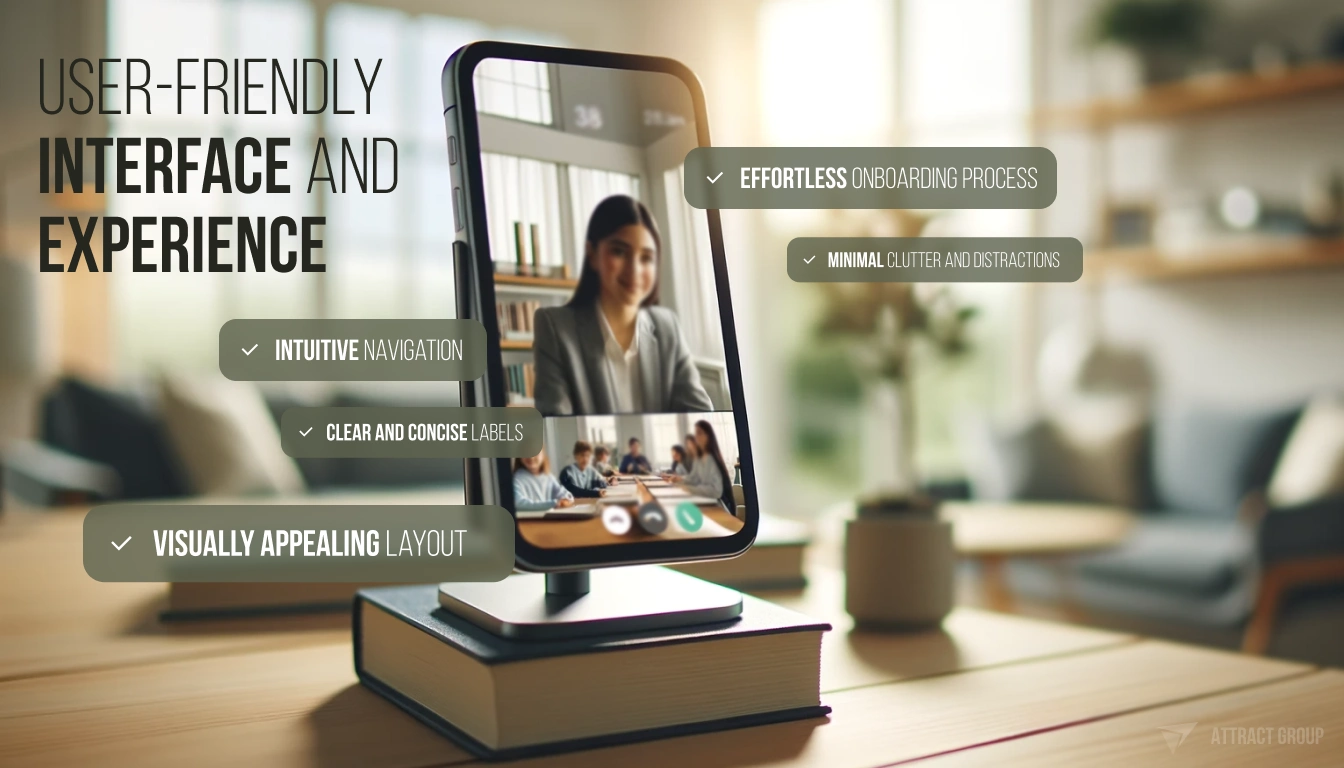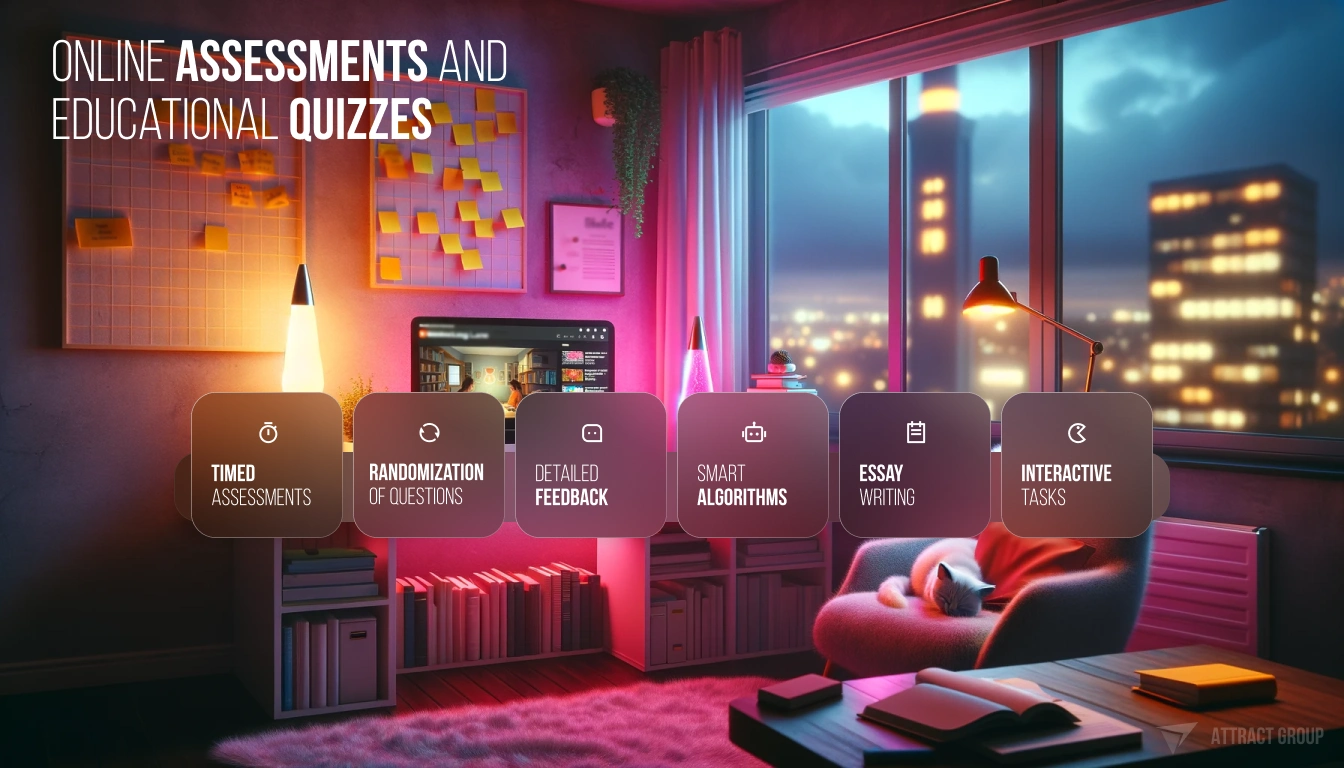Explore Top E-Learning Mobile App Features for Success
 17 November 2023
17 November 2023In recent years, the e-learning market has witnessed significant growth, with an estimated value of $350 billion expected by 2025. This expansion is driven by an increasing number of users seeking flexible learning options through E-Learning mobile app features, contributing to overall educational app success. The rise of mobile learning and advancements in e-learning app development have paved the way for EdTech companies to create innovative platforms catering to various demographics and needs, including language learning, school organization, pre-K education, virtual classrooms, and personal tutoring.
We have outlined the essential features and developments that contribute to the success of an e-learning mobile app, offering insights into the future of mobile education and the key elements app developers need to consider for a user-centric approach in EdTech innovation.
Key Takeaways
- The potential of a booming e-learning market with estimated growth to reach $350 billion by 2025.
- Increased demand for E-Learning mobile app features in education sectors and user flexibility.
- Importance of e-learning app development for companies and EdTech innovators in the future of education.
- Key considerations for developers include user-centric design, personalization, and effective communication.
- Incorporating impactful features such as gamification and multimedia content for greater engagement and educational success.
Our team of experts can help you design and build a custom e-learning app tailored to your educational needs. Get a free consultation.
Understanding the Rise of E-Learning Mobile Apps
The upsurge in the e-learning sector, particularly mobile applications, is primarily driven by accessibility and the adaptability of learning platforms to current technologies. Smartphones have democratized access to education, allowing users to pursue learning at their own pace, irrespective of location. Technological advances have eliminated the need for a physical classroom setting, with educational institutions rapidly adopting mobile apps to meet the demands of modern learners, especially during the global COVID-19 pandemic.
Smartphones have democratized access to education, allowing users to pursue learning at their own pace, irrespective of location.
The rise of mobile learning has led to significant e-learning market growth. Advancements in mobile education have resulted in seamless integration of multimedia content, real-time communication, and personalized learning environments, offering an unparalleled learning experience to users on the go.

Furthermore, the constant innovation in mobile technologies, such as augmented and virtual reality, has opened new avenues for enhanced learning experiences. These advancements continue to push the boundaries of mobile education, allowing for a more immersive and interactive approach to learning.
In today’s fast-paced and technology-driven world, the competitive landscape has prompted educational institutions and organizations to leverage the booming e-learning market. By doing so, they aim to cater to the ever-evolving needs and preferences of the modern learner, ensuring their organizational goals align with the expectations of an increasingly tech-savvy generation.
To summarize, the rise of mobile learning and advancements in mobile education are reshaping the e-learning landscape, driven by the need for greater accessibility and the adoption of cutting-edge technologies. As a result, the e-learning market is expected to witness unprecedented growth in the coming years, with mobile learning apps taking center stage in revolutionizing education.
Key E-Learning Mobile App Features for Enhanced User Engagement
A successful educational app must offer a seamless user interface (UI) that combines both aesthetics and functionality to engage learners effectively. An overwhelming interface can be off-putting, hence the need for a balance between feature-richness and user-friendliness. The UI/UX plays a pivotal role in the adoption and regular usage of the app by both students and educators.
User-Friendly Interface and Experience
An excellent interface design for educational apps should prioritize simplicity and clarity while retaining essential features. It should be easy to navigate, making it accessible to users of all ages and skill levels. A key aspect of a successful e-learning app is its ability to accommodate a wide range of user experiences in mobile education.
“The best interface is the one that’s both visually appealing and provides a seamless user experience that keeps learners coming back for more.”
Here are some elements to consider when designing a user-friendly e-learning app:
- Intuitive navigation
- Clear and concise labels
- Visually appealing layout
- Effortless onboarding process
- Minimal clutter and distractions

Responsive and Personalized Learning Environments
Responsive educational apps adapt their layouts and user interfaces to suit different devices and screen sizes, ensuring a consistent and enjoyable learning experience. In a world where learners access content through smartphones, tablets, and desktop computers, it is crucial to provide a seamless cross-device experience.
Personalized learning is another essential feature of modern e-learning apps. Customizable e-learning experiences cater to individual users’ needs and preferences, enhancing their engagement and learning efficacy. Here are some personalization features that can significantly improve the learning journey:
| Feature | Description |
|---|---|
| Personalized dashboards | Dashboard that displays relevant information, progress reports, and course recommendations based on the user’s activities and preferences |
| AI-driven course recommendations | Integration of artificial intelligence to analyze user activity, generate insights, and suggest suitable courses or materials relevant to the learner’s goals |
| Adaptive learning paths | Dynamic learning experiences that adapt based on a user’s progress, providing tailored support and challenges that cater to their unique learning needs |
| Customizable user interfaces | Allowing users to select or adjust layouts, color schemes, and settings to create a learning environment that suits their preferences |
User-friendly e-learning apps with responsive and personalized learning environments play a crucial role in enhancing user engagement and ultimately contributing to the success of the educational app in the market. Ensuring that your e-learning app prioritizes user interface, experience, and personalization will increase user satisfaction and loyalty, leading to lasting success in the competitive e-learning industry.

We specialize in building innovative and engaging e-learning apps. Our developers can help make your education app idea a reality.
The Role of Multimedia Content in Mobile Learning
The incorporation of multimedia content in e-learning has become a cornerstone of mobile learning, as it engages learners in a way that conventional text-based content cannot. By leveraging the power of video-based learning apps, interactive educational content, and other multimedia elements, modern e-learning platforms create immersive and dynamic learning experiences that cater to a wide range of learning preferences.
The importance of multimedia content in mobile learning can be attributed to its ability to make complex concepts more digestible, facilitate discussion, and increase knowledge retention. This revolution in mobile learning begins with video content.
Consider, for example, the rise of video-based learning apps such as Khan Academy and TED-Ed. These apps are increasingly popular among students as they provide classroom-like lessons that can be accessed anytime, offering the flexibility needed for a truly personalized learning journey.
- It caters to multiple learning styles by allowing users to pause, rewind, and zoom into clips, giving them control over their learning experience.
- Visuals and audio reduce cognitive load and increase retention, especially for abstract or complex concepts.
- Video lectures can be an effective substitute for in-person classes, bridging the gap between educators and learners across geographies.
Aside from video, interactive educational content is another key aspect of multimedia in mobile learning. Interactive elements can range from simulations, quizzes, and puzzles to virtual reality experiences that promote collaboration, critical thinking, and problem-solving.
“Tell me and I forget, teach me and I may remember, involve me and I learn.” – Benjamin Franklin
When it comes to multimedia content in e-learning, the future looks promising. As technologies continue to develop, we can expect to see even more immersive and engaging learning experiences that effectively leverage the strengths of various multimedia elements in mobile education. The combination of these factors will contribute to the ever-growing popularity of e-learning apps, offering meaningful and inclusive learning opportunities to students of all ages.
Incorporating Gamification to Foster Motivation and Retention
One of the most effective ways to increase user engagement in e-learning apps is by introducing gamification elements. Gamification refers to the implementation of game mechanics, such as points systems, badges, and leaderboards, into non-game environments. In the case of e-learning platforms, these elements can be used to enhance motivation and long-term retention among users.
Badges, Leaderboards, and Incentives
The integration of badges, leaderboards, and other incentives in e-learning platforms fosters a competitive spirit among users, making the learning experience more dynamic and engaging. A well-designed gamification strategy leverages these elements to provide users with rewards for their learning achievements, encourage progress, and drive the completion of course objectives. Some of the most popular gamification mechanics used in e-learning apps include:
- Badges: Visual representations of user achievements that can be collected and showcased on their profiles. Badges can increase motivation and provide a sense of accomplishment as users advance through course materials.
- Leaderboards: A ranking mechanism that encourages healthy competition among users by displaying their relative progress in comparison to others. Leaderboards can boost engagement by inspiring users to surpass their peers or their own previous achievements.
- Points and Educational Incentives: Awarding points for completing tasks or reaching milestones within the course material can incentivize users to stay engaged. Additionally, educational incentives, such as discounts on future courses or access to exclusive learning resources, can also be effective for maintaining user interest.

Applying gamification mechanics to e-learning platforms has proven both effective and enjoyable, fostering greater long-term retention and user engagement with the app.
Implementing gamification in e-learning apps helps users stay more connected to the learning process and actively involved in achieving their educational goals. When well-executed, these game mechanics can significantly improve long-term retention, enhance motivation, and encourage collaborative learning experiences.
| Gamification Mechanic | Purpose | Benefits for E-Learning Apps |
|---|---|---|
| Badges | Showcase achievements and progress | Increase motivation, provides a sense of accomplishment |
| Leaderboards | Encourage competition among users | Boost engagement, inspire self-improvement |
| Points and Educational Incentives | Incentivize course task completion and milestones | Maintain user interest, provide additional learning opportunities |
Gamification in e-learning apps has been shown to enhance both cognitive development and user engagement with the app. By incorporating badges, leaderboards, and other educational incentives, developers can create a captivating and motivating learning environment that fosters both retention and success for users of their e-learning platform.
Ensuring Accessibility: Offline Access and Mobile Compatibility
Accessibility is a critical aspect of e-learning mobile apps, allowing users to have a consistent learning experience regardless of internet connectivity. Offering offline access in e-learning whereby students can download modules ensures that learning is uninterrupted. Mobile compatibility ensures that the e-learning experience is optimized across different devices, expanding the reach and usability of the app.

Offline access is particularly beneficial for individuals with limited internet connectivity, reducing their dependency on uninterrupted internet connections for continuous learning. Some popular educational apps, such as Google Classroom and Coursera, offer offline-enabled course content. A few advantages of offering offline access are:
- Uninterrupted learning without requiring constant internet connectivity.
- Reduced data usage, making the app more cost-effective for students.
- Higher engagement levels, as users can access content anytime and anywhere.
Providing offline access to course materials can significantly increase user satisfaction and engagement, making e-learning apps more accessible and user-friendly.
Mobile compatibility is another essential aspect of accessible learning solutions, ensuring a seamless and optimized experience across various devices, including smartphones and tablets. This allows users to easily switch between devices without losing their progress or facing any compatibility issues. Mobile compatibility can be achieved by:
- Designing responsive interfaces that adapt to various screen sizes and orientations.
- Optimizing multimedia content (images, videos, and interactive elements) for different devices.
- Implementing cross-platform app development frameworks for maximum device coverage.
In conclusion, e-learning app developers must prioritize offline access and mobile compatibility to provide a truly accessible and uninterrupted learning experience for all users. These features not only make e-learning apps more user-friendly but also widen their appeal by catering to a diverse range of device preferences and internet connectivity limitations.
Seamless Communication Channels for Effective Collaboration
In today’s fast-paced digital world, fluid communication is paramount for engaging and effective learning experiences. Several e-learning app features can facilitate seamless communication in e-learning, promoting interaction among peers and instructors.

Peer-to-Peer Interaction and Instructor Feedback
For successful collaborative learning experiences, e-learning apps must foster a sense of community among students, encouraging peer interaction through features such as messaging, forum discussions, and group workspaces. This not only creates a supportive learning environment but also fosters dialogue and critical thinking among students.
Instructor feedback mechanisms enable educators to address student queries or provide guidance to enhance learners’ understanding of course materials. These mechanisms vary from live chat support to real-time feedback on assignments or discussion forums. Providing students with timely assistance can significantly improve learning outcomes and student satisfaction.
“The key to successful communication in e-learning is to enable learners and educators to effectively connect and share information, leading to meaningful learning experiences.”
Integrating Social Media for Community Building
Social media has become a powerful tool for connecting people and fostering strong communities. Many e-learning apps now leverage social media integration, enabling students not only to share achievements and resources with their friends and family but also to interact with fellow learners through educational networking.
These community-building features can include in-app posting, commenting capabilities, and sharing directly to major social media platforms. Establishing a robust e-learning community is essential for enhancing the sense of belonging and support, thereby creating an incredible learning experience and environment for every user.
- Access to private or public groups on social media for class discussions and resource sharing
- Connection with like-minded students and educators through profiles and social networking
- Sharing accomplishments and milestones on personal social media accounts, promoting a sense of pride and community among peers
Our dedicated teams have the skills to build and expand your education app or platform to support growing users and engagement.
In conclusion, seamless communication channels play an instrumental role in e-learning app success, ensuring effective collaboration, support, and educational networking. By incorporating robust peer-to-peer interaction, instructor feedback mechanisms, and social media integration, e-learning apps can transform the learning landscape and create highly valuable, engaging educational experiences.
The Importance of Tracking Progress and Performance Analytics
Monitoring students’ progress and analyzing their performance are vital aspects of e-learning apps. These features provide both learners and educators with insights into learning outcomes, enabling them to identify areas needing further attention and facilitating a more targeted approach to education.

Effective progress tracking and performance analytics in education offer data-driven insights that empower students and educators to make informed decisions about their learning.
Some key benefits of progress tracking and performance analytics in education include:
- Identifying students’ strengths and weaknesses to provide a personalized learning experience
- Enabling instructors to modify their teaching strategies based on students’ performance
- Allowing students to regularly assess their progress and set achievable goals
- Facilitating data-driven decisions for curriculum development and resource allocation
| Progress Tracking Features | Benefits |
|---|---|
| Goal-setting and milestone tracking | Empowers students to take charge of their learning journey and promotes accountability |
| Real-time progress reports | Students can see their progress in the context of overall course goals, helping visualize achievements |
| Individualized feedback and recommendations | Facilitates targeted interventions and guides learners towards relevant resources |
| Collaborative progress tracking | Enables peers and instructors to work together in monitoring student progress and providing feedback |
Performance analytics, on the other hand, provide a detailed understanding of the various factors impacting learning outcomes. This data-driven approach allows educators to pinpoint improvement opportunities and facilitates continuous adaptation to enhance the learning experience.
| Performance Analytics Features | Benefits |
|---|---|
| Engagement analytics | Tracks how students interact with learning content, revealing patterns that inform instructional design |
| Assessment analytics | Identifies critical trends in test performance, exposing knowledge gaps and informing assessment design |
| Usage analytics | Monitors app usage to understand which features are most valuable for learners and areas for improvement |
| Feedback analytics | Analyzes student feedback to incorporate suggestions and refine the overall learning experience |
By integrating progress tracking and performance analytics into e-learning apps, developers can significantly enhance the user experience while enabling educators and learners to maximize the potential of their online learning endeavors.
Adopting Online Assessments and Quizzes for Knowledge Validation
Online assessments and educational quizzes serve as vital components in the e-learning process, offering learners immediate validation of the knowledge they acquire. They allow students to test their understanding and retention of course material and provide educators with insights into the effectiveness of their teaching methods.

With the advancement of technology, online assessment tools have evolved to become more engaging and dynamic. These tools often include features such as:
- Timed assessments to simulate real exam conditions.
- Randomization of questions and answers to prevent cheating.
- Detailed feedback to help students understand their strengths and weaknesses.
- Smart algorithms that adapt to the learner’s progress and tailor the difficulty level accordingly.
Moreover, online assessments can be delivered in various formats to cater to different learning styles and preferences. Some popular formats include:
- Multiple choice questions
- Fill in the blanks
- Matching exercises
- Essay writing
- Interactive tasks such as drag and drop or simulations
Implementing educational quizzes and online assessments in the e-learning process can yield numerous benefits for both learners and educators. These benefits include:
| Benefits for Learners | Benefits for Educators |
|---|---|
| Immediate feedback on performance | Data-driven insights into teaching effectiveness |
| Enhanced motivation and engagement | Improved learning outcomes through targeted intervention |
| Better preparedness for traditional exams | Reduced workload with automated grading and analysis |
| Personalized learning paths based on performance | Efficient resource allocation and curriculum development |
Online assessments and quizzes empower learners to take charge of their education, measure their progress, and gain valuable insights into their performance – ultimately enabling a more personalized and effective learning experience.
Integrating online assessments and educational quizzes into e-learning platforms is crucial for knowledge validation. This approach harnesses the potential of technology to deliver engaging and informative learning experiences while enabling instructors to better support their learners’ individual needs and goals. As e-learning continues to evolve, adopting these assessment methods will undoubtedly play a significant role in shaping the future of education.
Video: How China Is Using Artificial Intelligence in Classrooms
This insightful piece by the Wall Street Journal delves into the pioneering use of AI in Chinese classrooms, showcasing how cutting-edge technologies like brainwave-sensing headbands and facial recognition are being integrated into the educational experience. From monitoring students’ concentration levels to tracking their health and engagement, this video reveals the extensive and sometimes controversial measures being taken to enhance learning and discipline. As we explore these advancements, questions about privacy, effectiveness, and the long-term implications of such technologies in shaping future generations are brought to the forefront. Join us in uncovering the depths of this AI-driven educational revolution in China:
Conclusion
In conclusion, the future of mobile education relies heavily on the effective implementation of key features in the e-learning app development process. The unprecedented growth of the e-learning market dictates the significance of creating innovative and engaging educational apps that cater to the ever-evolving needs of the target audience. A user-centric approach, coupled with unique functionalities, can provide users with an unparalleled learning experience, ultimately leading to the success of these applications.
Investing in the development of mobile learning apps that are accessible, intuitive, and responsive is indispensable in today’s competitive educational landscape. As users demand more personalized and engaging digital learning environments, a keen focus on incorporating features such as multimedia content, gamification, seamless communication channels, performance analytics, and online assessments becomes paramount. These features not only benefit the users but also contribute to the growth of app developers in the fast-paced EdTech industry.
With our custom e-learning app development services, we can build innovative education solutions tailored to your needs and vision.
By paying critical attention to these essential parameters, businesses and educational institutions can establish a firm footing in the realm of mobile education. This will enable them to leave an indelible mark in the e-learning market, which is characterized by significant potential and a promising outlook for developers who are determined to redefine the traditional learning experience.
FAQ
What are the key factors driving the rise of e-learning mobile apps?
The upsurge in the e-learning sector, particularly mobile applications, is primarily driven by accessibility and the adaptability of learning platforms to current technologies. Smartphones have democratized access to education, allowing users to pursue learning at their own pace, irrespective of location. The global COVID-19 pandemic further accelerated the adoption of mobile apps as a means of education.
How does a user-friendly interface and personalized learning environment contribute to the success of e-learning apps?
A successful educational app must offer a seamless user interface (UI) that combines both aesthetics and functionality to engage learners effectively. Personalization features in e-learning mobile apps are essential as they tailor the learning experience to individual users, enhancing engagement and efficacy.
What role does multimedia content play in mobile learning?
Multimedia content has become central to mobile learning, with video-based modules offering students the flexibility to access classroom-like lessons anytime. They cater to the diverse learning styles of students, making video content a transformative force in the educational app industry.
How can gamification features be incorporated into e-learning apps?
Gamification introduces game mechanics into non-game environments, such as e-learning apps, to increase motivation and retention. Examples of gamification elements include digital badges, leaderboards, and various incentives that not only make learning more engaging but also encourage a competitive spirit among users.
Why is accessibility, such as offline access and mobile compatibility, crucial for e-learning apps?
Accessibility is a critical aspect of e-learning mobile apps, allowing users to have a consistent learning experience regardless of internet connectivity. Offering offline access whereby students can download modules ensures that learning is uninterrupted. Mobile compatibility ensures that the e-learning experience is optimized across different devices, expanding the reach and usability of the app.
How do seamless communication channels contribute to effective collaboration in e-learning?
Seamless communication channels allow for peer-to-peer interactions and mechanisms for receiving instructor feedback, which are essential for collaborative learning and enhancing the understanding of educational content. Integrating social media in e-learning apps creates opportunities for community building, fostering a sense of belonging and support among learners.
Why is tracking progress and performance analytics important in e-learning apps?
Tracking progress and analyzing performance are vital features of e-learning apps as they provide both students and educators with insights into learning outcomes. Detailed analytics help in identifying areas that require more focus, thereby facilitating a more targeted approach to education.
How do online assessments and quizzes support knowledge validation in e-learning?
Online assessments and quizzes are integral to the learning process as they provide immediate validation of the knowledge acquired. They help learners test their understanding and retention of course material and enable educators to gauge the effectiveness of their teaching methods.










